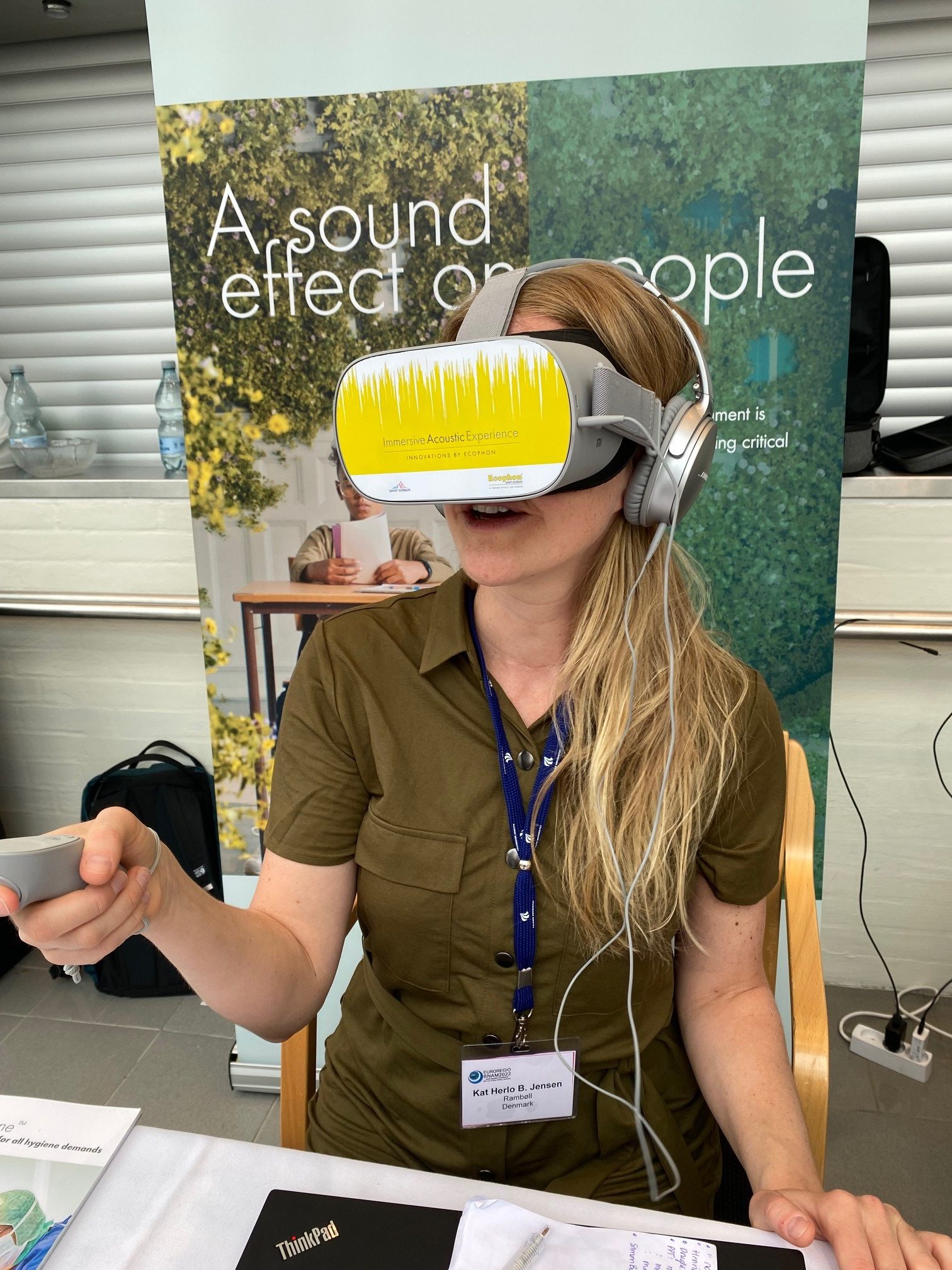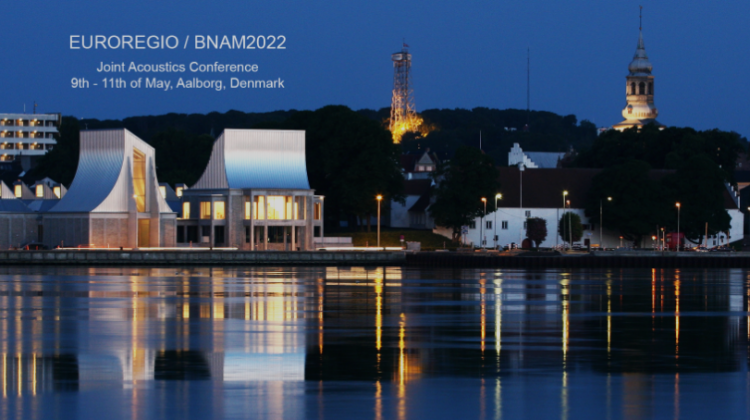
On May 9-11 2022, Aalborg hosted the bi-annual Baltic Nordic- Acoustic Meeting (organized by the Nordic Acoustic Association), which this time is merged with the EUROREGIO (organized by the European Acoustics Association).  The conference brought together academics, engineers, consultants, and other practitioners in the wide field of acoustics. Some of the really interesting presentations are described here but you can find the program, abstracts and papers here.
The conference brought together academics, engineers, consultants, and other practitioners in the wide field of acoustics. Some of the really interesting presentations are described here but you can find the program, abstracts and papers here.
Keynote: Health effects of traffic noise: results from a nationwide study
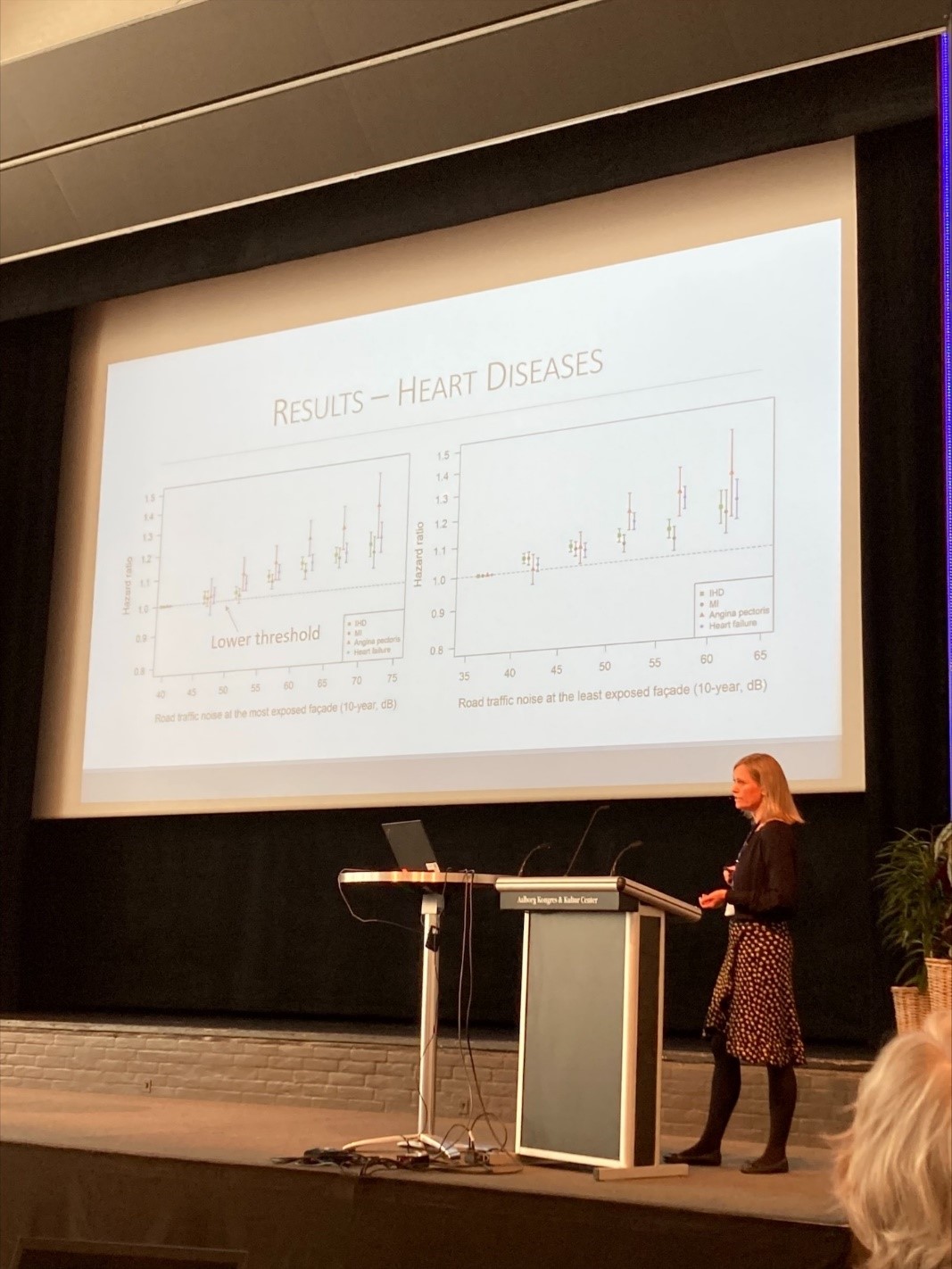
The BNAM conference in Aalborg was opened with a fascinating keynote speech on the links between traffic noise levels and health, including cancer. The speaker was Dr. Mette Sørensen, Senior Researcher at the Danish Cancer Society and Professor at the Department of Natural Science and Environment at Roskilde University. Dr. Sørensen has focused on the health effects of traffic noise since 2010 and was among the first to publish research papers showing associations between road traffic noise and stroke, heart failure, diabetes, breast cancer and dementia.
The underlying theory is that the harmful effects of noise are primarily triggered through an indirect pathway. That is, once the noise has been perceived, the adrenal and nervous systems become activated and cause a rise in stress hormones, and disturbances of sleep quality and quantity.
During her talk, Dr. Sørensen presented a massive-scale research project that modelled the effects of road and railway noise on people living at 2.8 million residential addresses across Denmark between 1990 and 2017. From this model they were able to extract the average noise exposure in the population and compare with illnesses reported in national health registries (eg. Danish Cancer Reigstry).
The study specifically compared the facades of the house that were “most exposed” versus “least exposed” to noise due to their respective distances from the street. “Least exposed” facades were hypothesized to be the side of the house which most people were likely to be sleeping, and so noise increases on this side were considered most likely indicative of sleep disturbance due to noise
Dr. Sørensen reported the noise increases during the time period measured resulted in significantly higher risk of stroke as well as various forms of cancer (breast cancer, lymphoma), particularly when the noise increase was on the “least exposed” façade (i.e. the place most essential for rest and recovery).
In summary, these findings really stress the importance of undisturbed sleep and noise-free environments in the places where we live. In particular, this highlights that a zero-tolerance policy regarding noise during the night is the only sensible approach.
For more on this topic, please see her article “Road and railway noise and risk for breast cancer: A nationwide study covering Denmark”.
Perception of Virtual Reality Based Audiovisual Paradigm for People with Hearing Impairment
Kang Sun from the Eriksholm Research Centre gave a presentation on the integration of new and emerging technologies, such as virtual reality (VR), with established test methods to improve ecological validity. Ecological validity, in psychology, is a measure of how test performance predicts behaviors in real-world settings and it is gradually used by practitioners in some fields of soundscape research, but remains limited use in hearing science. In this paper, an audiovisual setup was introduced to administrate an augmented speech-in-noise test for people with hearing impairment. The environment stimuli contained four competing talkers recorded with 360-degree video and ambisonics audio. The video was displayed in the VR headset, while the audio was presented to the participants via a loudspeaker array. Furthermore, a silent and fixed physical avatar was included in the video recording as a placeholder for the audio stream of the target speech. Very interesting speech that also included simulator sickness measurements!
Health effects of environmental noise in a wind power area
Valtteri Hongisto from Turku University of Applied Sciences presented the findings of a study of the effects of both Wind turbine noise and Road Traffic noise, on symptoms and diseases close to wind turbines and in a control area. Wind turbine sound levels met the Finnish regulation (40 dB) and the daytime road traffic noise levels were 32.5-63.5 dB.
The health effects of wind farms seem to be limited to noise annoyance in areas where all residents are exposed to sound levels below 40 dB. On the other hand, more than 600.000 inhabitants are exposed to road traffic noise levels above 55 dB in Finland. Because high road traffic noise is associated with elevated prevalence of symptoms and disease in the study, and several previous international studies have found even more serious health effects of road traffic noise, Valteri believes this issue deserves higher concern in the future.
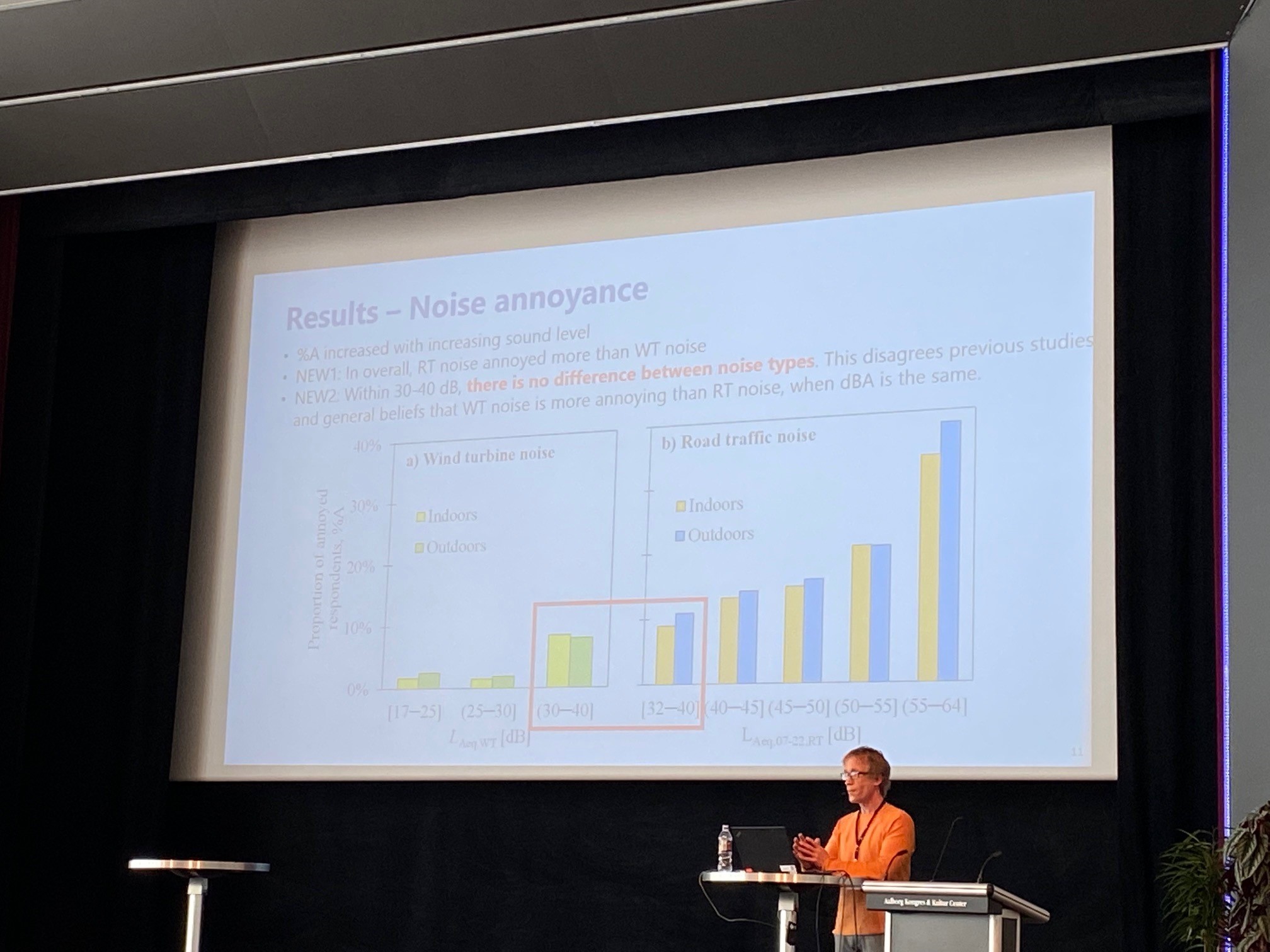
The maximum outcome on Wind turbine noise is close to the values of the lowest Traffic noise, indicating that when the purpose of the questionnaire is masked the impact on people’s perceived health is not expressed!
Situations where users always wear or take off their hearing aids
Sreeram Kaithali Narayanan, Aalborg University
Narayanan could see a slight drizzle start as he kicked off the last talk on the first day of the conference. The talk provided some interesting insights on the use of hearing aids (HA) by users, in different situations. The idea is that understanding different situations in which the users always wore or took off their hearing aids can provide insight into their exposed soundscapes and preferences. And also provide knowledge of the shortcomings in the functional and user experience aspects of the hearing aids. The results are informative for both audiologists and audiologists, as well as for designers who design spaces for people wearing hearing aids. For audiologists to better inform their clients on the use of hearing aids as to mitigate clients putting out their hearing aids – using them at all times during the day improves the effectiveness of the devices. For designers to make more inclusive designs of their spaces mitigating for instance chances for social isolation – Narayanan and his colleagues for example found that users are more likely to take off their hearing aids in crowded situations.
This study uses the data collected from 1487 HA users in the Better hEAring Rehabilitation (BEAR project). The participants were asked two questions as part of the one-year online follow-up;
1) if in any situation they always took off their HAs?
2) if in any specific situation they always wore their HAs?
If they answered ”Yes” to these questions, ten choices of everyday situations were presented. The result showed that more than 57% of the users took off their HAs in one or more of these situations. It was found that most of the HA users preferred to take off their HAs during physical activities. HA users preferred always to wear their HAs at work and while watching TV.
Feasibility of inhomogeneous MPPs in multipurpose halls: The case study of Bilkent Concert Hall in Ankara
Mrs. Ela Fasllija from the Bilkent University, Department of Interior Architecture and Environmental Design in Turkey.
In multipurpose halls, there are additional constraints in planning for good visual conditions and sightlines, meeting specific social demands concerning layout, and providing good acoustic conditions. Regarding the latter, they require a compromise between the auditory needs of speech and music.
While conventional materials fail to absorb sounds in the low-frequency range, Helmholtz resonators show a very narrow absorption bandwidth. The researchers investigated inhomogeneous Micro-Perforated Panels (MPPs), which have a wider absorption bandwidth in the low-mid frequency spectrum. They analyzed the Bilkent concert Hall, a 700-seat capacity multipurpose trapezoid-shaped hall by assessing the fundamental acoustic parameters such as reverberation time, sound pressure levels, and speech transmission index. Comparative simulations between the existing and the proposed material-based solution showed an improvement in the reverberation time and other objective acoustic criteria when inhomogeneous MPPs were used as wall panels instead of conventional materials!
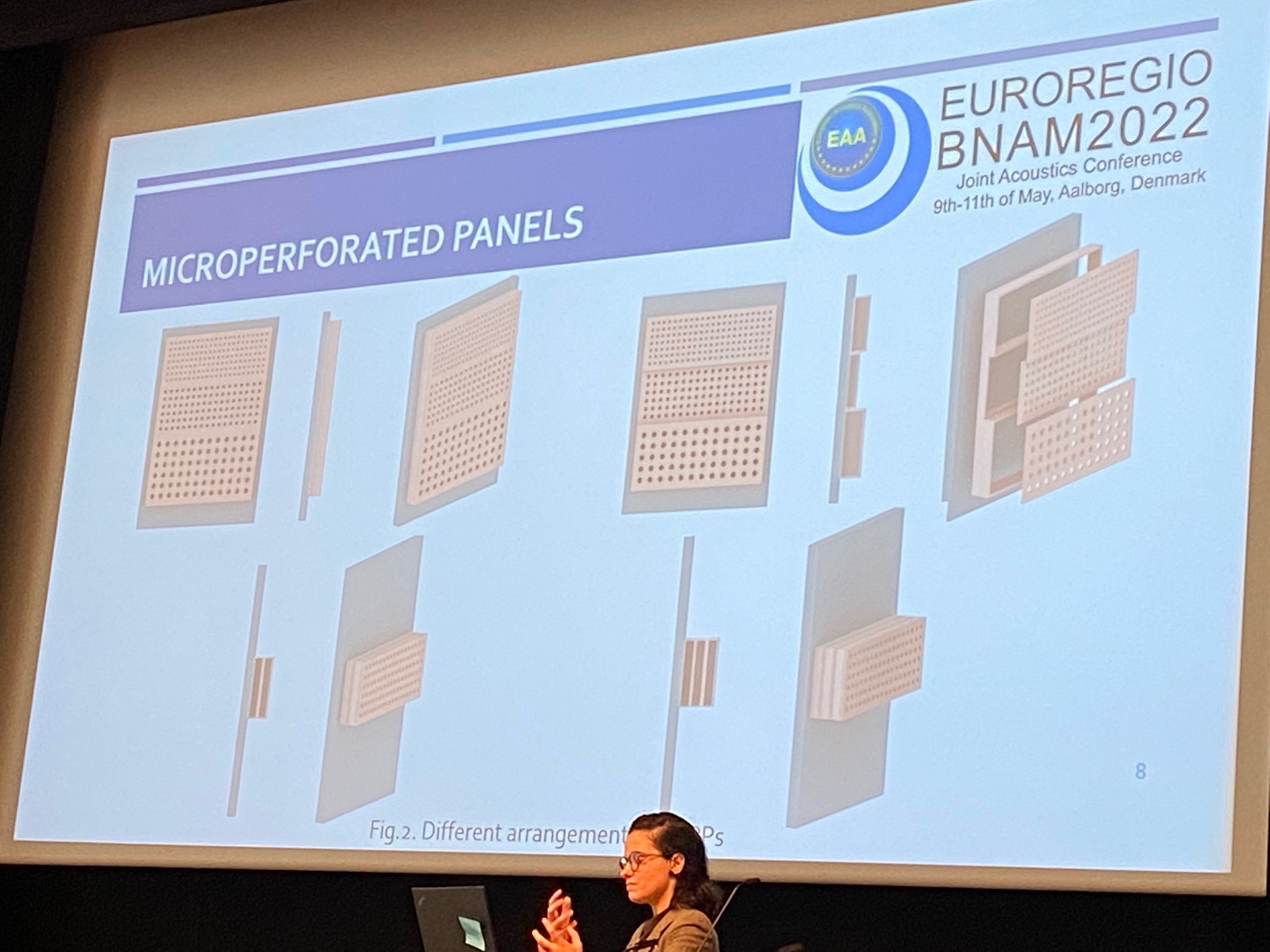
Study tour at Musikkens hus (The House of Music)
Acoustic meeting also in practice! On the waterfront of Aalborg with an unobstructed view of the Limfjord, you will find Musikkens Hus: the North Jutland’s musical gathering point, and an architectural gem designed by the internationally renowned architectural firm Coop Himmelb(l)au. Spread over more than 20,000 m2, it houses both concert halls, a restaurant, and teaching and administration facilities.
On the guided study tour we had the opportunity to see, and hear, a real rehearsal of the symphony orchestra which was very appreciated! The concert hall seats 1298 guests and at the beginning of the rehearsal, we were invited to change listening positions to compare the subjective experience. A very popular activity among all the acousticians and fellow sound-enthusiastic BNAM guests!
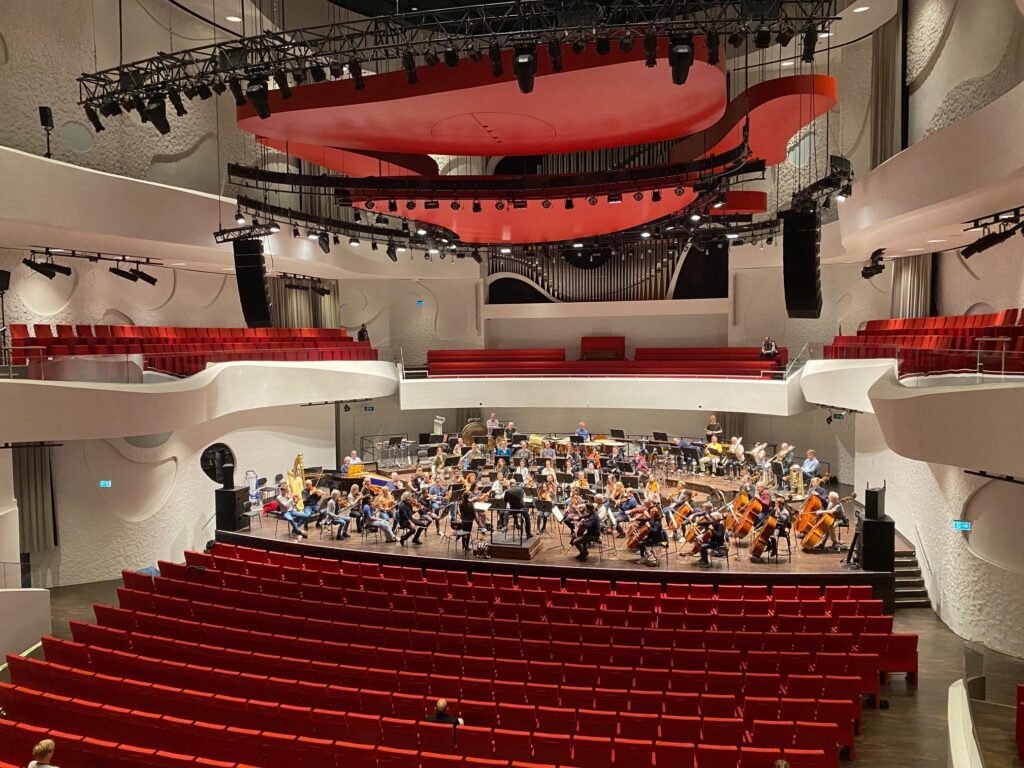
Musikkens Hus is beautifully connected to the fjord and the theme of water continues into the building through harmonic architectural care. It is not only meant to be a concert hall but a center for all types of music. On the lower levels, 3 smaller rooms have been built, with adapted acoustics for practicing different types of music: The Rhythmic Hall, the Classical Hall, and the Intimate Hall. Our guides performed singing tests in all three halls and there was of course a big difference acoustically between the rooms. acoustic meeting in practice indeed!
Deep machine learning in audiology: Models of speech perception and self-conducted speech audiometry
Bernd T. Meyer, Carl von Ossietzky University
Deep machine learning resulted in a major performance boost in many research fields such as computer vision, natural language processing, and automatic speech recognition (ASR). Bernd provided examples of how this technology can be exploited in the context of audiology and speech enhancement. Models of speech perception were introduced with the aim of predicting speech intelligibility and the perceived speech quality, and the subjective listening effort for normal-hearing and hearing-impaired listeners.
Phoneme probabilities from a deep neural network were calculated; the degradation of these probabilities in the presence of noise, reverberation or other distortions was quantified, which results in the model output.
Noise-robust ASR could be used for conducting listening tests where the subject listens to a noisy sentence and responds with the words he or she recognized. In a clinical setting, such a test is guided by a human supervisor who logs the correct word responses, which is time-consuming and expensive. Bernd presented some of their results for speech audiometry using an ASR system in the clinic and introduced an Alexa skill for performing screening procedures.
Room Acoustic design for electronic enhancement systems
Henrik Möller at Akukon Helsinki
Within the last 10-15 years, electroacoustic enhancement systems have become a real tool to improve the acoustic conditions in multi-functional halls, both as full systems, where the total acoustic field is created electronically, and as an extension of existing acoustic conditions in the hall. However, one common misconception is that it is possible to ”repair the acoustics” or fix problems with an electroacoustic enhancement system. The fact is that good acoustic conditions are necessary for the successful implementation of an electroacoustic enhancement system. Henrik gave us a brief overview of the current technology and the typical acoustic requirement and examples of solutions.
Sound insulation, residents’ satisfaction, and design of wooden residential buildings
Fredrik Ljunggren, Luleå University of Technology
Over the last few years, wood-based multi-family houses continue to grow in popularity. Low-frequency sounds and sound insulation have been in focus for a long time. And in a series of Swedish research projects running for 12 years, the correlation between rated annoyance from residents and measured airborne and impact sound insulation, have been studied. In total, 38 building cases of various constructions were involved and more than 1200 questionnaire responses were collected.
While the building code’s present evaluation parameter for airborne sound insulation, D’nT,w + C50-3150, seems to be working well, the situation is different concerning respect to impact sound insulation. L’nT, was as well as L’nT,w + CI,50-2500 show a weak correlation with the rated annoyance from the residents. The reason is that frequencies below 50 Hz are overlooked, although they dominate the response from walking in many common, particularly lightweight, floor constructions. The strongest correlation with the rated annoyance from impact sound, including both lightweight and heavyweight constructions, was found when the measured frequency range was extended down to 25 Hz, using L’nT,w + CI,25-2500.
The sound of coffee. A predictive model for the sound quality of espresso machines
Laura Rossi, Capgemini Engineering
The fact that we eat also with our eyes is known for a long time, but today it was also emphasized that we drink coffee with our ears! The sound of making coffee matters to the customer. Customers are looking for acoustic comfort in their homes, which affects the choice of equipment.
To be able to predict how people will like the sound of not yet developed espresso machines the team of Capgemini Engineering with Laura Rossi, has developed a mathematical model that allows the prediction of the sound quality of coffee brewing, not only the sound level but also sharpness, roughness, fluctuation strength, and spectral content. The SQI (Sound Quality Index) value corresponds to the evaluation that a human jury would express if called to assess the sound submitted to the model. Sound quality tools and psychoacoustics metrics in combination to objectify the subjective perception. I am longing for that perfect cup of coffee with all my senses!
Saint-Gobain Ecophon
We had the great joy of being part of the exhibition in this acoustic meeting where we showed some of our latest material and offered a virtual tour of various room types of schools and healthcare premises. Below acoustic engineer Kat Herlo from Ramböll is exploring the soundscape in an Intensive Care Unit with various treatments of sound absorbing ceiling tiles and wall panels. Thanks for all the very nice conversations in our both, and during the whole conference and, of course, in the coffee breaks!
Ready for more about BNAM – check out last years summary here!
